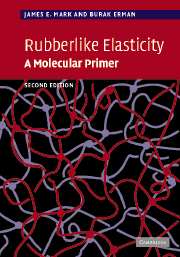Book contents
- Frontmatter
- Contents
- Preface to the first edition
- Preface to the second edition
- Part I Fundamentals
- 1 Introduction
- 2 Some rubberlike materials
- 3 The single molecule: theory and experiment
- 4 Preparation and structure of networks
- 5 Elementary statistical theory for idealized networks
- 6 Statistical theory for real networks
- 7 Elastic equations of state and force–deformation relations
- 8 Swelling of networks and volume phase transitions
- 9 Force as a function of temperature
- 10 Model elastomers
- Part II Additional topics
- Appendix A Relationships between ν, ξ and Mc
- Appendix B Relationships between 〈r2〉, 〈(Δr)2〉, 〈r2〉0, and ϕ
- Appendix C Equations of state for miscellaneous deformations from the constrained junction theory
- Appendix D Thermodynamics of the relationship of stress to temperature
- Problems
- Answers to problems
- Some publications describing laboratory/classroom experiments or demonstrations
- References
- Index
10 - Model elastomers
from Part I - Fundamentals
Published online by Cambridge University Press: 04 December 2009
- Frontmatter
- Contents
- Preface to the first edition
- Preface to the second edition
- Part I Fundamentals
- 1 Introduction
- 2 Some rubberlike materials
- 3 The single molecule: theory and experiment
- 4 Preparation and structure of networks
- 5 Elementary statistical theory for idealized networks
- 6 Statistical theory for real networks
- 7 Elastic equations of state and force–deformation relations
- 8 Swelling of networks and volume phase transitions
- 9 Force as a function of temperature
- 10 Model elastomers
- Part II Additional topics
- Appendix A Relationships between ν, ξ and Mc
- Appendix B Relationships between 〈r2〉, 〈(Δr)2〉, 〈r2〉0, and ϕ
- Appendix C Equations of state for miscellaneous deformations from the constrained junction theory
- Appendix D Thermodynamics of the relationship of stress to temperature
- Problems
- Answers to problems
- Some publications describing laboratory/classroom experiments or demonstrations
- References
- Index
Summary
Effects of network structure on elastomeric properties
General approach
Until recently, there was relatively little reliable quantitative information on the relationship of stress to structure, primarily because of the uncontrolled manner in which elastomeric networks were generally prepared (Flory, 1953; Treloar, 1975; Erman and Mark, 1997). Segments close together in space were linked irrespective of their locations along the chain trajectories, thus resulting in a highly random network structure in which the number and locations of the cross links were essentially unknown. Such a structure was shown in Figure 1.2. New synthetic techniques are now available, however, for the preparation of “model” polymer networks of known structure. More specifically, if networks are formed by end linking functionally terminated chains instead of haphazardly joining chain segments at random, then the nature of this very specific chemical reaction provides the desired structural information (Erman and Mark, 1997; Mark, 2004a; Mark et al., 2004). Thus, the functionality of the cross links is the same as that of the end-linking agent, and the molecular weight Mc between cross links and its distribution are the same as those of the starting chains prior to their being end linked.
An example is the reaction shown in Figure 10.1, in which hydroxyl-terminated chains of a polymer such as poly(dimethylsiloxane) (PDMS) are end linked using tetraethyl orthosilicate (alternatively called tetraethoxysilane).
Information
- Type
- Chapter
- Information
- Rubberlike ElasticityA Molecular Primer, pp. 93 - 108Publisher: Cambridge University PressPrint publication year: 2007
Accessibility standard: Unknown
Why this information is here
This section outlines the accessibility features of this content - including support for screen readers, full keyboard navigation and high-contrast display options. This may not be relevant for you.Accessibility Information
- 2
- Cited by
